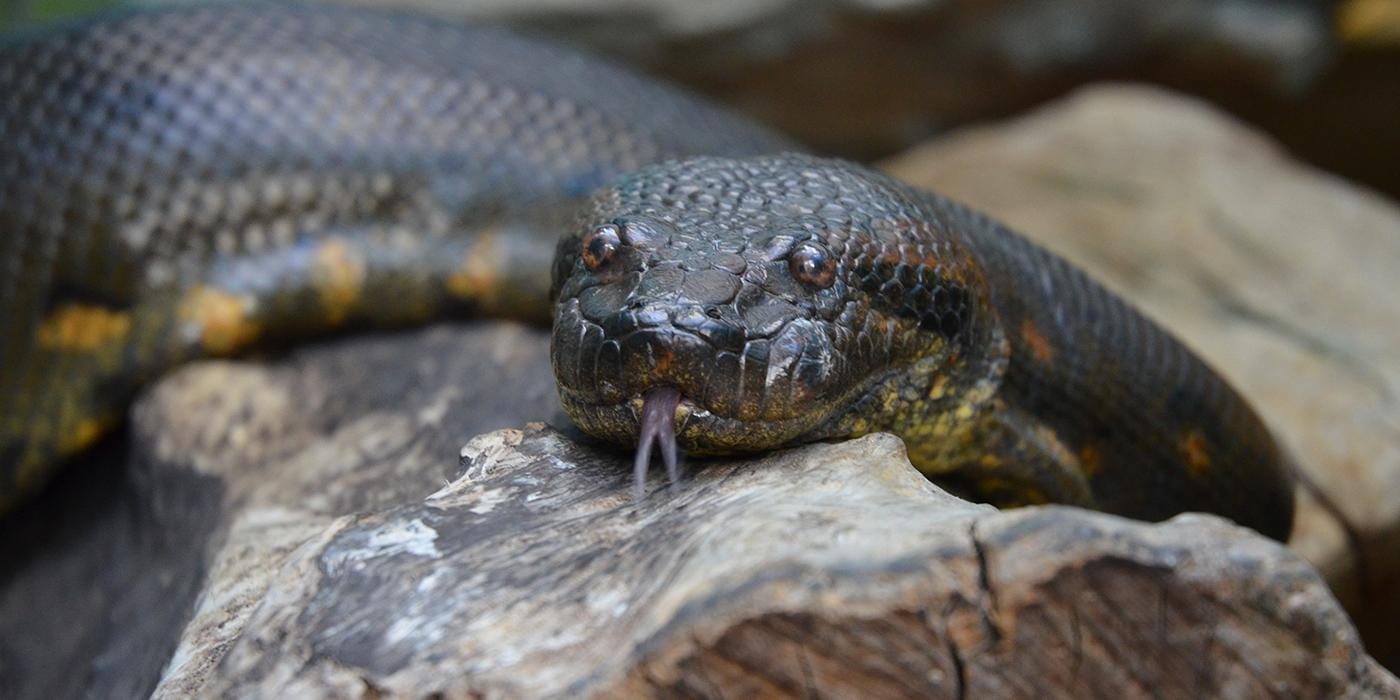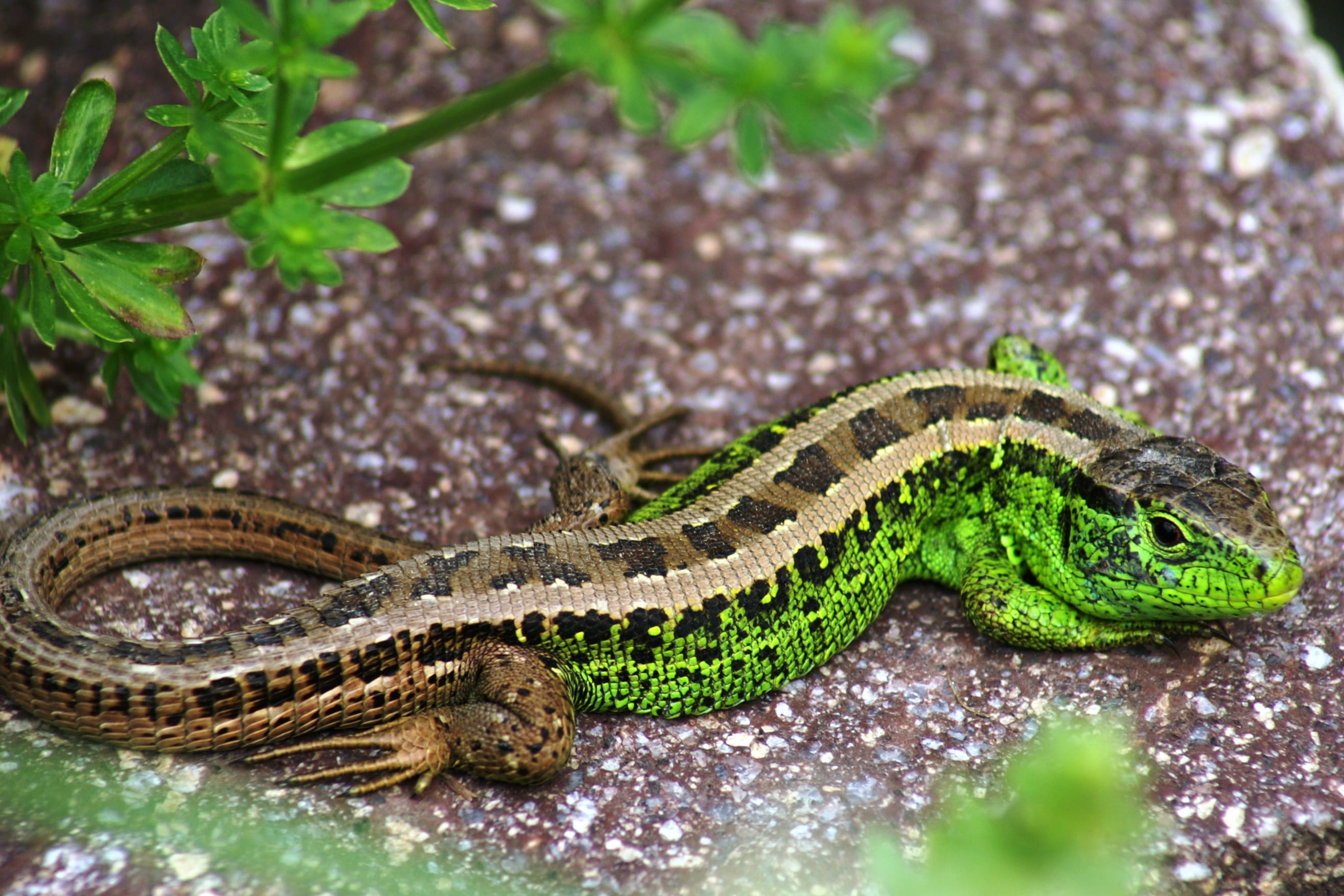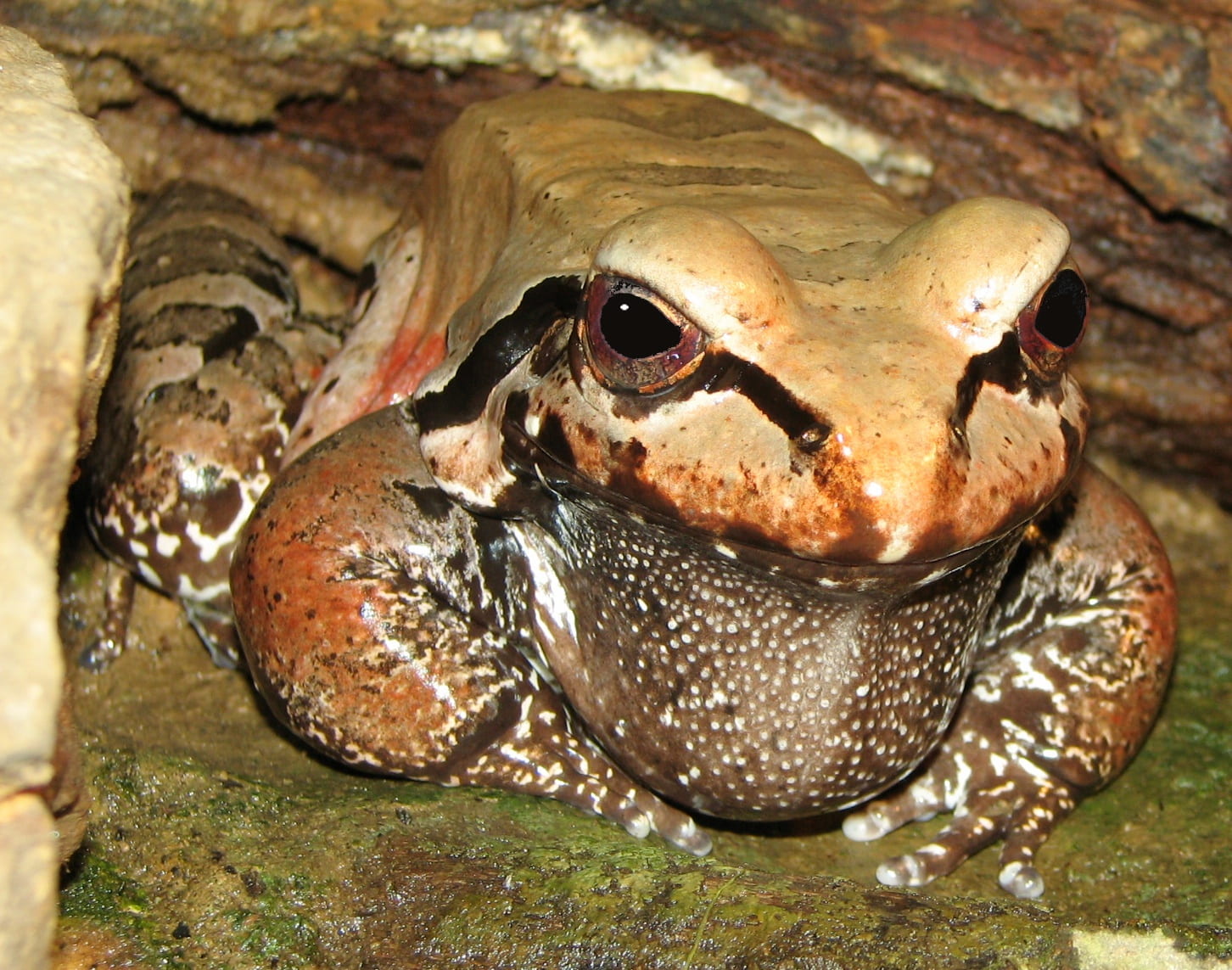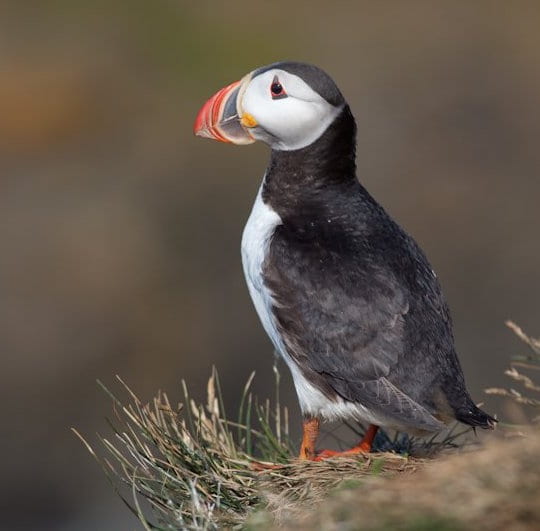by Contributing Editor Spencer J. Weinreich
King Philip Came Over For Good Soup. Kingdom, Phylum, Class, Order, Family, Genus, Species. Few mnemonics can be as ubiquitous as the monarch whose dining habits have helped generations of biology students remember the levels of the taxonomic system. Though the progress of the field has introduced domains (above kingdoms), tribes (between family and genus) and a whole array of lesser taxons (subspecies, subgenus, and so on), the system remains central to identifying and thinking about organic life.

Green anaconda (Eunectes murinus): a reptile, not an amphibian (photo credit: Smithsonian’s National Zoo)
Consider “reptiles.” Many a precocious young naturalist learns—and impresses upon their parents with zealous (sometimes exasperated) insistence—that snakes are not slimy. The snake is a reptile, not an amphibian, covered with scales rather than a porous skin. Reaching high school biology, this distinction takes on taxonomic authority: in the Linnaean system, reptiles and amphibians belong to separate classes (Reptilia and Amphibia, respectively). The division has much to recommend it, given the two groups’ considerable divergences in physiology, life-cycle, behavior, and genetics. But, like all scientific categories, the distinction between reptiles and amphibians is a historical creation, and of surprisingly recent vintage at that.
When Carl Linnaeus first published his Systema Naturæ in 1735, what we know as reptiles and amphibians were lumped together in a class named Amphibia. The class—“naked or scaly body; molar teeth, none, others, always; no feathers” (“Corpus nudum, vel squamosum. Dentes molares nulli: reliqui semper. Pinnæ nullæ”)—was divided among turtles, frogs, lizards, and snakes. Linnaeus concludes his outline with these words:
the benignity of the Creator chose not to extend the class of amphibians any further; indeed, if it should enjoy as many genera as the other classes of animals include, or if that which the teratologists fantasize about dragons, basilisks, and such monsters were true, the human race could hardly inhabit the earth” (“Amphibiorum Classem ulterius continuare noluit benignitas Creatoris; Ea enim si tot Generibus, quot reliquæ Animalium Classes comprehendunt, gauderet; vel si vera essent quæ de Draconibus, Basiliscis, ac ejusmodi monstris si οι τετραλόγοι [sic] fabulantur, certè humanum genus terram inhabitare vix posset”) (n.p.).

Sand lizard (Lacerta agilis), an amphibian according to Linnaeus (photo credit: Friedrich Böhringer)
In the 1758 canonical tenth edition of the Systema, Linnaeus provided a more elaborate set of characteristics for Amphibia: “a heart with a single ventricle and a single atrium, with cold, red blood. Lungs that breathe at will. Incumbent jaws. Double penises. Frequetly membranaceous eggs. Senses: tongue, nose, eyes, and, in many cases, ears. Covered in naked skin. Limbs: some multiple, others none” (“Cor uniloculare, uniauritum; Sanguine frigido, rubro. Pulmones spirantes arbitrarie. Maxillæ incumbentes. Penes bini. Ova plerisque membranacea. Sensus: Lingua, Nares, Oculi, multis Aures. Tegimenta coriacea nuda. Fulcra varia variis, quibusdam nulla”) (I.12). Interestingly, Linnaeus now divides Amphibia into three, based on their mode of
locomotion:
- Reptiles (“those that creep”), including turtles, lizards, frogs, and toads;
- Serpentes (“those that slither”), including snakes, worm lizards, and caecilians;
- Nantes (“those that swim”), including lampreys, rays, sharks, sturgeons, and several other types of cartilaginous fish (I.196).

Smokey jungle frog (Leptodactylus pentadactylus), a reptile according to Laurenti and Brongniart (photo credit: Trisha M. Shears)
Linnaeus’s younger Austrian contemporary, Josephus Nicolaus Laurenti, also groups modern amphibians and reptiles together, even as he excludes the fish Linnaeus had categorized as swimming Amphibia. Laurenti was the first to call this group Reptilia (19), and though its denizens have changed considerably in the intervening centuries, he is still credited as the “auctor” of class Reptilia. The French mineralogist and zoologist Alexandre Brongniart also subordinated “batrachians” (frogs and toads) within the broader class of reptiles. All the while, exotic specimens continued to test taxonomic boundaries: “late-eighteenth-century naturalists tentatively described the newly discovered platypus as an amalgam of bird, reptile, and mammal” (Ritvo, The Platypus and the Mermaid, 132).
It was not until 1825 that Brongniart’s compatriot and contemporary Pierre André Latreille’s Familles naturelles du règne animal separated Reptilia and Amphibia as adjacent classes. The older, joint classification survives in the field of herpetology (the study of reptiles and amphibians) and the sadly underused word “herptile” (“reptile or amphibian”).
“Herptile” is a twentieth-century coinage. “Reptile,” by contrast, appears in medieval English; derived from the Latin reptile, reptilis—itself from rēpō (“to creep”)—“reptile” originally meant simply “a creeping or crawling animal” (“reptile, n.1” in OED). The first instance cited by the Oxford English Dictionary is from John Gower’s Confessio Amantis (c.1393): “And every neddre and every snake / And every reptil which mai moeve, / His myht assaieth for to proeve, / To crepen out agein the sonne” (VII.1010–13). The Vulgate Latin Bible uses reptile, reptilis to translate the “creeping thing” (רֶמֶשׂ) described in Genesis 1, a usage carried over into medieval English, as in the “Adam and Eve” of the Wheatley Manuscript (BL Add. MS 39574), where Adam is made lord “to ech creature & to ech reptile which is moued on þe erþe” (fol. 60r). Eventually, these “creeping things” became a distinct group of animals: an early sixteenth-century author enumerates “beestes, byrdes, fysshes, reptyll” (“reptile, n.1” in OED). I suspect the identification of the “reptile” (creeping thing) with herptiles owes something to the Serpent in the Garden of Eden being condemned by God to move “upon thy belly” (Gen. 3:14). The adjective “amphibian” is attested in English as early as 1637, but in the sense of “having two modes of existence.” Not until 1835—after the efforts of Latreille and his English popularizer, T. H. Huxley—does the word come to refer to a particular class of animals (“amphibian, adj. and n.” in OED).
The crucial point here is that the distinction between the two groups, grounded though it may be in biology and phylogenetics, is an artifact of taxonomy, not a self-evident fact of the natural world. For early modern, medieval, and ancient observers, snakes and salamanders, turtles and toads all existed within an ill-defined territory of creeping, crawling things.
Fourteenth-century icon of Saint George and a very snakelike dragon (photo credit: Museum of Russian Icons, Moscow)
The farther back we go, the more fantastic the category becomes, encompassing dragons, sea serpents, basilisks, and the like. Religion, too, played its part, as we have seen with Eve’s serpentine interlocutor: Egypt’s plague of frogs, the dragon of Revelation, the Leviathan, the scaly foes of saints like George and Margaret, were within the same “reptilian”—creeping, crawling—family. To be sure, the premodern observer was perfectly aware of the differences between frogs and lizards, and between different species (what could be eaten and what could not, what was dangerous and what was not). But they would not—and had no reason to—erect firm ontological boundaries between the two sorts of creatures.
When we go back to the key works of medieval and ancient natural philosophy, the same nebulosity prevails. Isidore of Seville’s magisterial Etymologies of the early seventh century includes an entry “On Serpents” (“De Serpentibus”), which notes,
the serpent, however, takes that name because it crawls [serpit] by hidden movements; it creeps not with visible steps, but with the minute pressure of its scales. But those which go upon four feet, such as lizards and geckoes [stiliones could also refer to newts], are not called serpents but reptiles. Serpents are also reptiles, since they creep on their bellies and breasts” (“Serpens autem nomen accepit quia occultis accessibus serpit, non apertis passibus, sed squamarum minutissimis nisibus repit. Illa autem quae quattuor pedibus nituntur, sicut lacerti et stiliones, non serpentes, sed reptilia nominantur. Serpentes autem reptilia sunt, quia ventre et pectore reptant.”) (XII.iv.3).
The forefather of premodern zoology, Aristotle, opines in Generation of Animals “there is a good deal of overlapping between the various classes;” he groups snakes with fish because they have no feet as easily he links them with lizards because they are oviparous (II.732b, trans. A. L. Peck).

Atlantic puffin (Fratercula arctica), a reptile according to modern phylogenetics (photo credit: NOAA Photo Library—anim1991)
As it turns out, our modern category of “reptile” (class Reptilia) has proved similarly elastic. In evolutionary terms, this is because “reptiles” are not a clade—a group of organisms defined by a single ancestor species and all its descendants. Though visually closer to lizards, for example, genetically speaking the crocodile is a nearer relative to birds (class Aves). Scientists and science writers have thus claimed—sometimes facetiously—that the very category of reptile is a fiction (see Welbourne, “There’s no such thing as reptiles”). The clade Sauropsida, including reptiles and birds (as a subset thereof), was first mooted by Huxley and subsequently resurrected in the twentieth century to address the problem. Birds are now reptiles, though they seldom creep. If I may be permitted a piece of Isidorean etymological fantasy, perhaps this is the true import of the “reptile” as “creeping thing,” as they creep across and beyond taxonomic boundaries, eternally frustrating and fascinating those who seek to understand them.



May 31, 2017 at 12:50 pm
Reblogged this on IBHE Collaborative University.